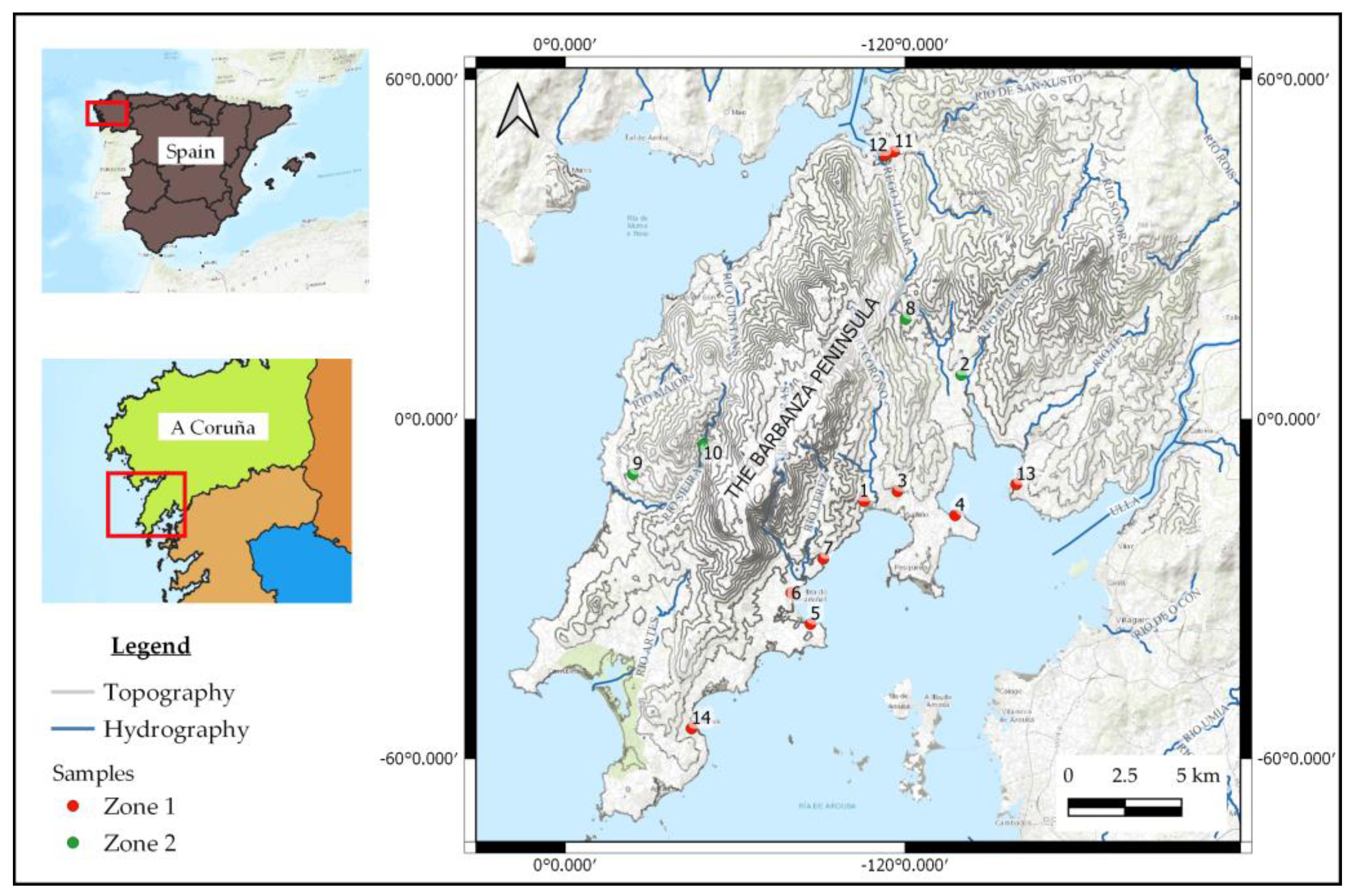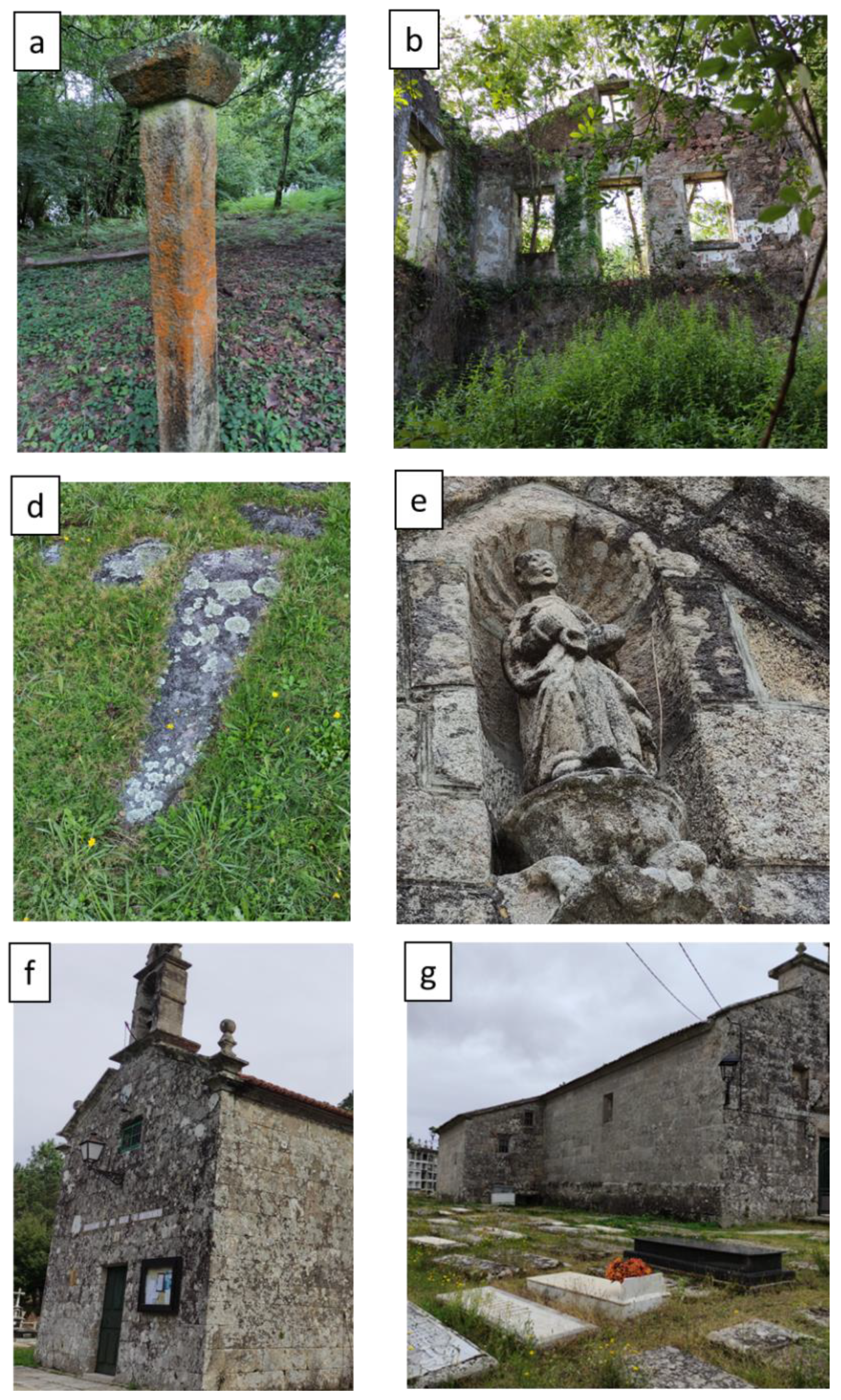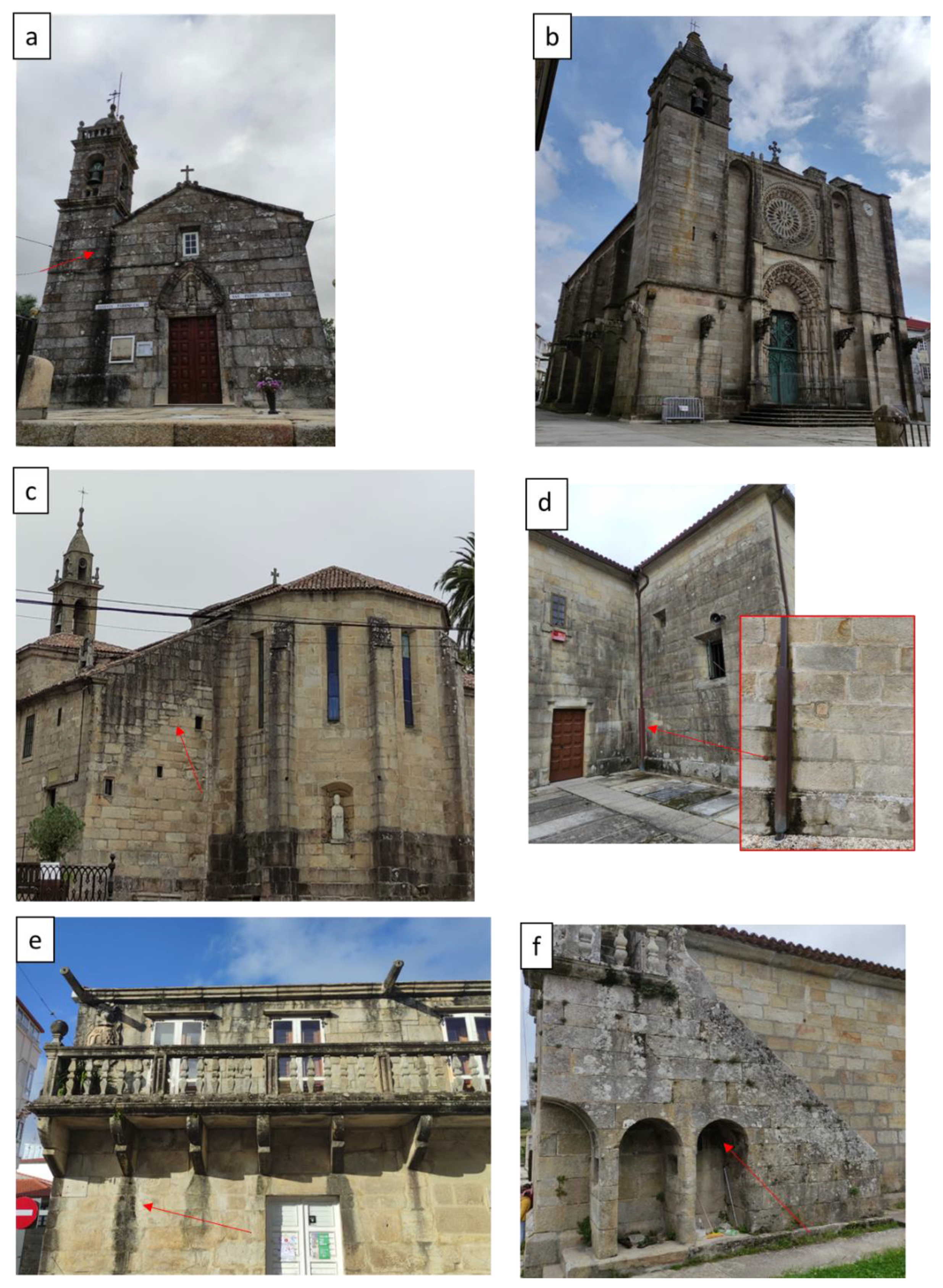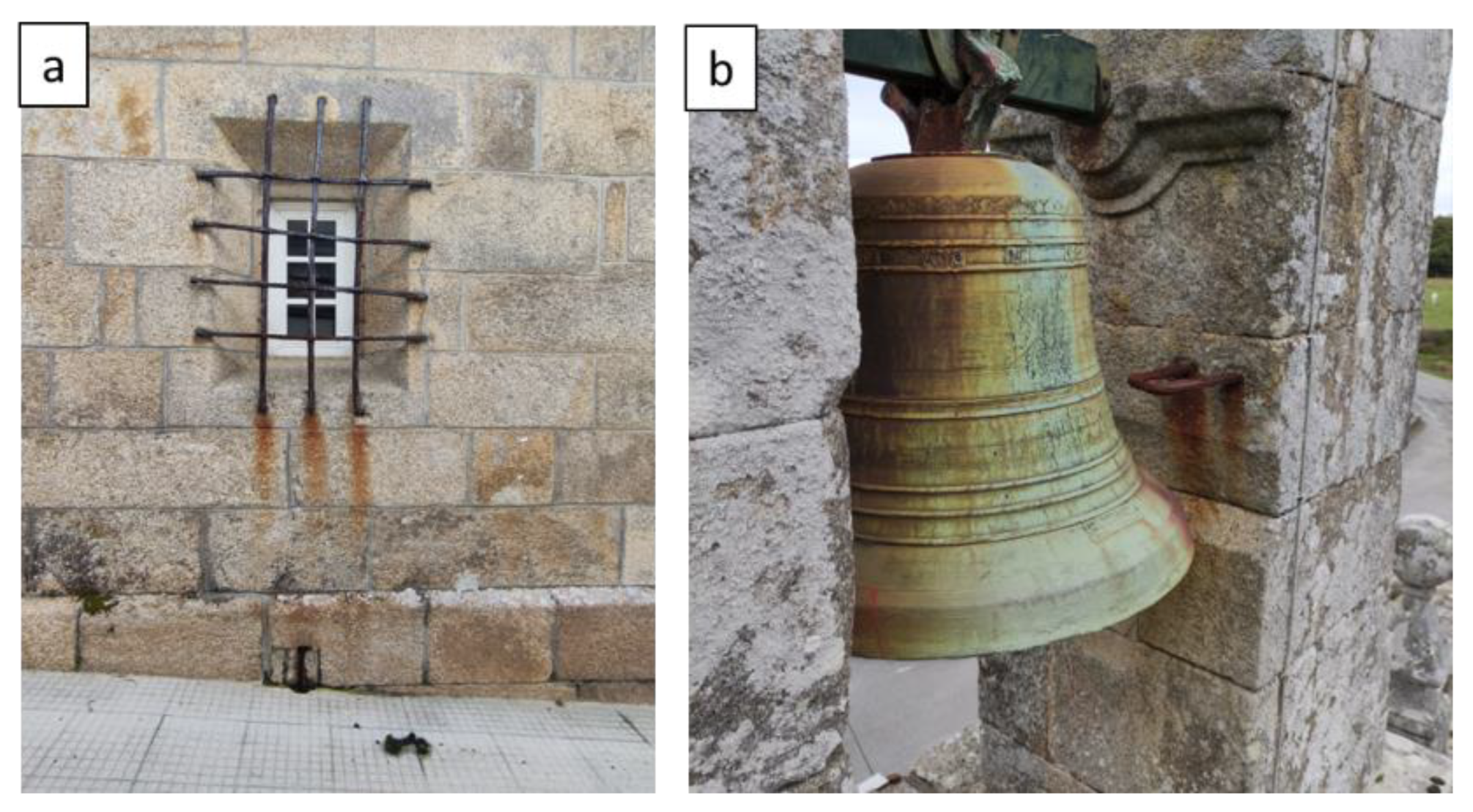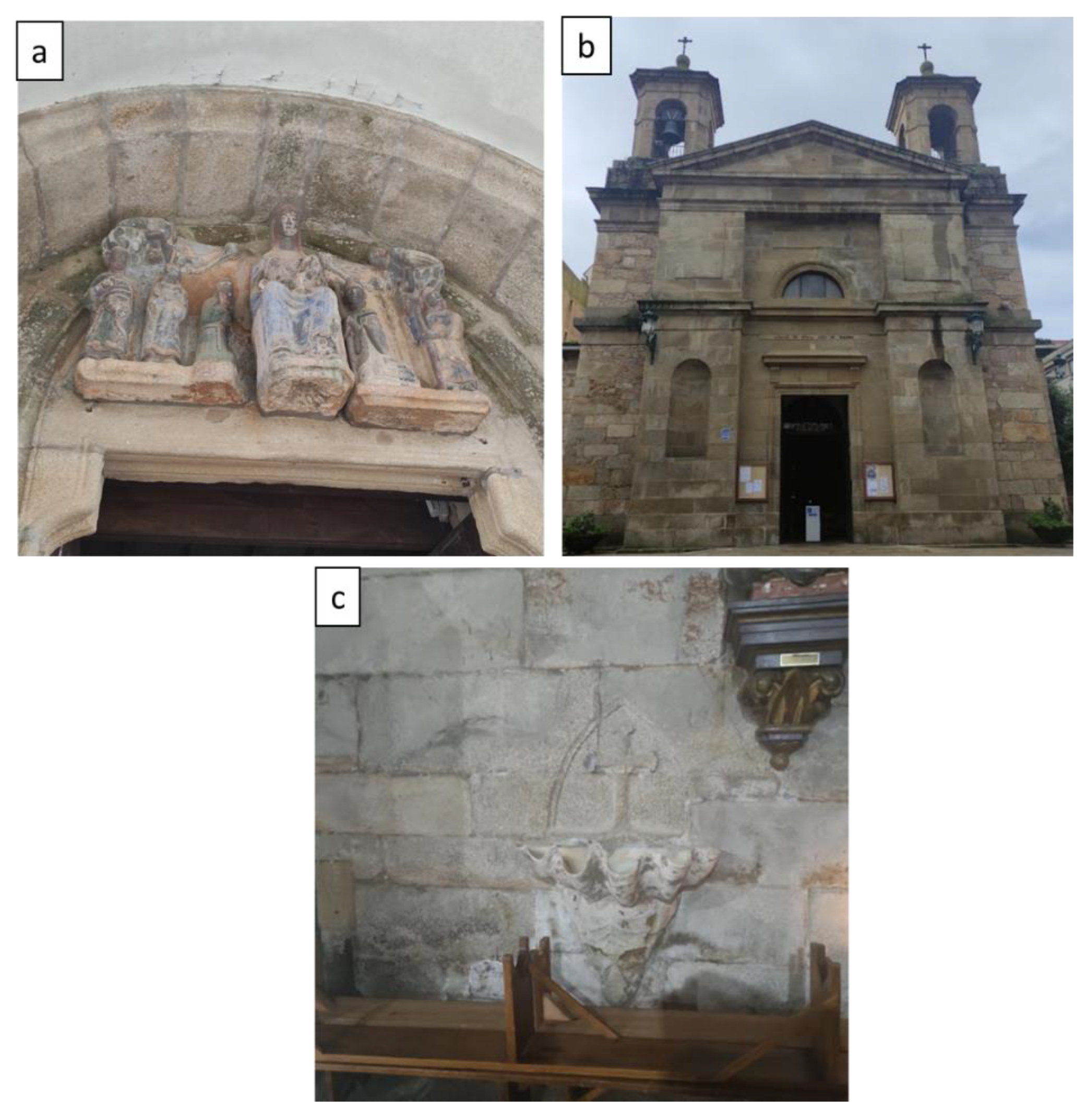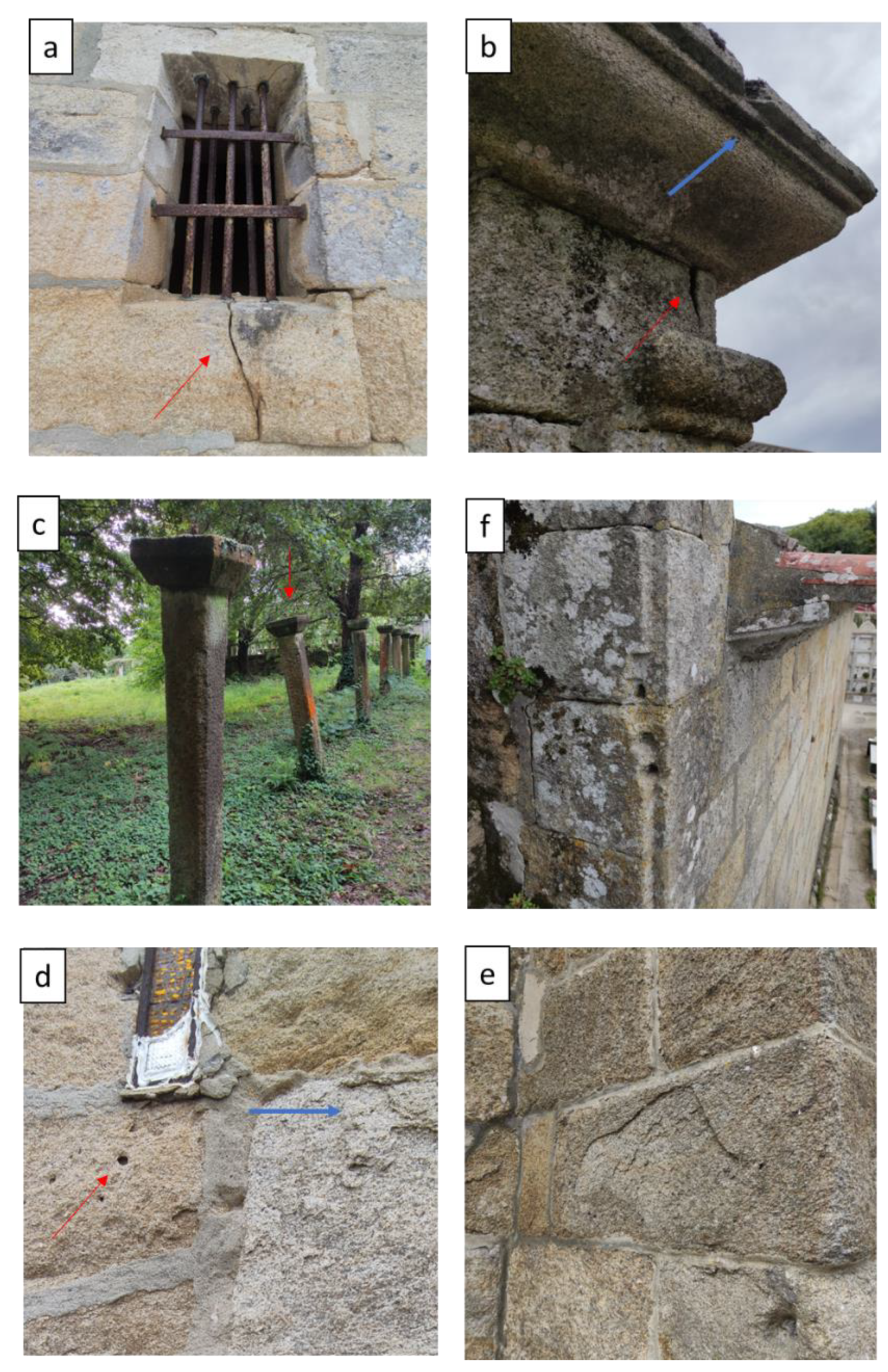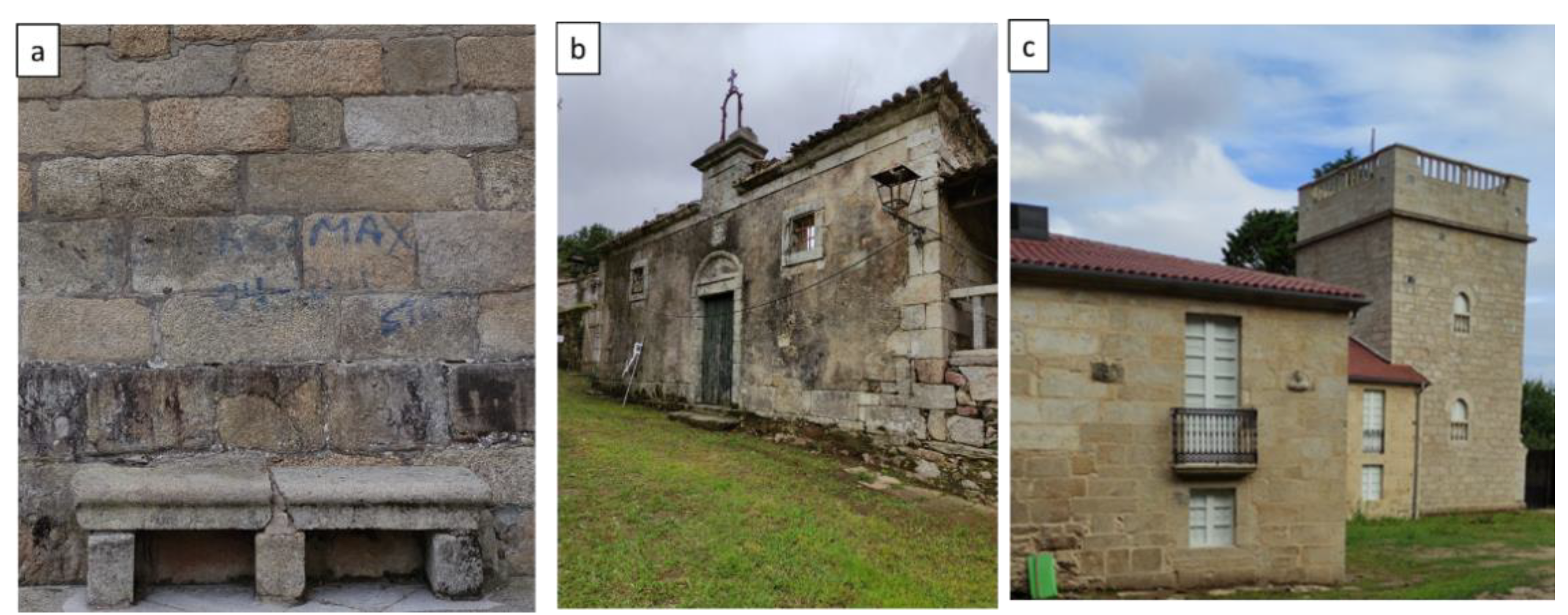1. Introduction
Historically, stone materials extracted from quarries or mines have been used in construction of valuable architectures that, in many cases, represent a cultural heritage that must be preserved. This is because the stone is generally considered one of the most resistant materials [
1]. In Galicia (NW Spain), one of the most used stone materials is granite, but other materials such as schist, gneiss and marble have also been historically used. Despite its attractive properties and theoretical hardness, stone materials (historical scale) are exposed to the weathering agents (water, salts, wind, organism, redox processes). Anthropic-related factors accelerate the susceptibility to alteration that can have a negative impact (decay). The consequence of this impact is the deterioration of stone, being the state of conservation of the heritage deficient along time [
2,
3,
4,
5,
6]. The level of deterioration or decay is influenced by both the type of stone and the environmental conditions to which the cultural object is exposed (climate and environmental pollution) since the relationship of both determines the kinetics of deterioration.
Since the 19th, and above all 20th century, air pollution due to mostly industrial activities and car traffic has accelerated and therefore the causes of deterioration are not only natural, but anthropogenic. Therefore, human activities can speed up deterioration, but also slow it down through conservation measures. For this reason, studies on the decay of building materials have been abundant in the last 30 year focused on the characterization of materials and deterioration processes regarding the lithology, decay mechanisms, causes and restoration procedures [7, 8, 9, 10, 11, 12].
The main aim of this work is to compare and characterize the state of decay developed in a set of 14 monuments made in stone (churches and Galician traditional house, locally called “pazos”) of the architectural heritage of the Barbanza Peninsula (Western Galicia, in NW Spain). We have considered the possible relationship of decay with their spatial distribution, influence of environmental factors, age of building and type of rock used for construction. For possible conservation works, a previous knowledge of the current situation and extensive information on the stone material used in construction is necessary. It is also important to point out that few studies of this type are carried out in rural areas, since most are concentrated on large monuments (cathedrals) and urban areas. Thus, this study attempts to supply useful information to provide measures for the restoration and preservation of built heritage in the area. As this is not a very populated area (approximate area of 350 km² and population density near about 270 inhabitants/km²) we focus our study on the effect of an evident environmental factor: the possible effect of seaside spray and weathering processes on the decay of stone, from a macroscopic perspective.
2. Materials and Methods
2.1. Study Area: (Geography, climatological setting and geology)
2.1.1. Geography
The Barbanza Peninsula is a well-defined and consolidated geographical area, being the northernmost of the peninsulas located on the Western Coast of Galicia. It is located specifically to the north of the Rías Baixas (SW of the province of A Coruña), between the Arousa (to the South) and Muros-Noia (to the North) estuaries (
Figure 1). It has an area of 416 km
2 defined by its main geographical feature: the Sierra de Barbanza, a mountain chain formed at the end of the Tertiary, more than 6 km long that runs longitudinally, in a NE-SW direction. Its average altitude is 500 meters above sea level and its highest part is made up of small plateaus, being Iroite the highest peak of the Peninsula (687 m), separated by hills and crossed by several small river valleys, where highlight the Pedra and Coroño. Thus, two large groups are distinguished: on the one hand, the slopes (mostly with very pronounced and abrupt escarpments) and on the other hand, the coastal platforms, strips of altitude less than 200 m located to the North and Southeast (with relief where smooth forms predominate), alternating beaches, sandbanks and rocky cliffs behind which a narrow coastal plain extends (which expands in certain places).
2.1.2. Climatological setting
The Barbanza Peninsula belongs to the Humid Ocean domain [
13], characterized by a reduced annual thermal oscillation and accentuated rainfall with a winter maximum, although with a pronounced tendency towards summer aridity.
The range of annual precipitation is just under 900 mm in the coastal area and more than 3300 mm collected in the highest levels of the mountains, appreciating a clear correlation between precipitation, altitude and topographic position. In fact, in Ribeira the annual precipitation is around 1250 mm, while in Boiro is about 2000 mm. Further, the distribution of rainfall throughout the year is very irregular, but is more abundant during the three winter months (about 40% of the annual total) [
14].
The average temperature ranges between 18.5 °C in the summer and 9.5 °C in the winter (typical of a temperate climate in a Humid Ocean domain) appreciating a notable variation with altitude which is especially noticeable in the duration of the seasons. The contrasts between the closer to sea (coastal platform) and elevated (the slopes) zones are notorious, for example, in the risks of frost, that do not exist in the lower levels, but with incidence in the high-level areas.
There are two prevailing winds, from the SW in winter, associated with storms and from N to NE in the summer, more moderate. The highest speeds are usually reach during the spring, when they tend to oscillate between 20 and 40 km/h, although sometimes (in autumn) they even reach 80 km/h.
In any case, despite its small size, the presence and orientation of the Sierra de Barbanza favours the existence of a certain climatic variability, not very pronounced, reflected in the proportional increase in rainfall rates with respect to altitude, and in the existence of higher temperatures in those areas open to warm air from the ocean.
2.1.3. Geology
The Peninsula Barbanza includes a lithological variety with a predominance of granite [
15]. Among the types of granites, the one with the greatest representation is the granite with two micas of medium-coarse grain, called the Barbanza type, the majority in the entire central sector. In the Corrubedo area (SW) is transformed into a fine-grained variant. An example of churches with Barbanza-type granite are the churches of San Xoán de Macenda or Santa Maria de Ribasieira (
Figure 2).
Another type of granite form part of the Migmatitic Domain: oriented, physical, and glandular granitic rocks that have undergone a process of migmitization and later metasomatism are distinguished. This type of oriented granite is visible in churches such as: San Martiño de Noia (
Figure 2). In the NE of the peninsula, the NOYA Complex is found, which is formed by a granite of two medium-grain micas.
Other rocks types present are the shale, gneiss and other metamorphic materials that make up the blastomylonitic pit. The structures of some of the churches and Pazos studied include, in addition to granite, metamorphic rocks (such as Pazo da Merce).
Less represented, but not for that reason of less interest, are the deposits of Quaternary origin, made up of materials of sedimentary origin and located mainly in coastal areas.
2.2. Description of built heritage
The study is carried out on a total of 14 architectural monuments distributed throughout the Barbanza peninsula (
Figure 1) and covering of community the Boiro, Rianxo, Noia, Ribeira, Porto do Son, Lousame and Pobla do Caramiñal. The types of monuments are churches [
16], chapels with significant value and country houses. The "pazos" represent admirable stately homes, a kind of small rural palace, typical of the Galician landscape and that express the model of life based on country economic activities and the climate. However, it is notable in many cases the abandonment of these constructions and the little existing information related to the construction and especially to their state of conservation. It is noteworthy that they were built in different century, so their state of conservation, style and architectural features are very variable.
The following table (
Table 1) summarizes some of the description of each of the selected monuments, considering the factors to be taken into account that may contribute in different ways to the degree of deterioration: lithology, altitude, distance from the sea and construction age. It is important to note that despite the fact that metamorphic rocks (schists and gneiss) have been found in some bases and other reconstructed walls, the studies will be carried out on the granite rock façades.
The monuments were divided into two distinguishable zones (map 1): those located on the slopes of the Sierra de Barbanza called zone 1 and those located on the coastal platform called zone 2.
2.3. Methodology.
A total of 14 monuments were studied during the summer season of 2021, as indicated in
Table 1 and a careful macroscopic characterization was carried out to identify patterns of deterioration of the monuments studied. Spatial analyses were undertaken in Geographic Information Systems (GIS) environment and QGIS 3.12. software was used.
3. Results and discussion
The in-situ observations have revealed different patterns of deterioration [
17], where aesthetic and, in some cases, structural damage was identified. In general, the most frequent forms of deterioration are biological colonization, discolouration, deposit and detachment, but also dark crusts, and efflorescence (
Table 2), which coincides with the most common forms of deterioration in other monuments previously studied in the NW Iberian Peninsula [18, 19]. The marine influence and climatic conditions are the mainly responsible for the most important pathologies observed in the Barbanza Peninsula. The appearance and abundance of these depend on the factors of the environment, facade orientation and the construction material.
The most notorious pathologies of the Barbanza monuments are biological colonization. Bacteria, cyanobacteria, algaes, fungi, lichens and plants, as has been previously reported in this type of rock [20, 21]. Thus, lichens are the most common microosganisms in the study area. They form several types of biofilms with variable colour, texture and thickness. The majority form white sposts but green, yellow, black, red and orange liches have been found also. The common appearance is that of crustose and others are foliose. In several cases, not only one species predominates but they are mixed (
Figure 3a). Other organisms present are the same ones that grow in preferably horizontal and shady areas. In addition, higher plants that usually appear between cracks or on roofs are also present. Depending on the state of abandonment, they can invade the entire monument, as is the case of the Pazo de la Merced (
Figure 4b) or the Chapel of the Pazo de Goians.
Due to the fact that biological colonization is always associated with the presence of water, it is normal to think that due to the wetness regime and the characteristics of the stone material, most of the monuments of the Barbanza peninsula are affected by this pathology. They not only affect the different parts of the monument but also elements such as tombstones, statues and plaques (
Figure 3c, 3d) . However, differences in distribution and abundance of colonization can be distinguished considering four issues: 1) The highest areas of the peninsula (zone 2) with respect to the lowest (zone 1), 2) the marine environment in zone 1, 3) the humidity (ascending, descending or localized) and 4) the orientation and distribution of the facades.
Ubication: In the highest parts of the peninsula (zone 2) the fluvial regime and forest vegetation are greater than in zone 1, therefore these monuments presented greater alteration due to biological colonization (
Figure 3e). An example is the Church of Ribasieria (PU3) one of the most recent and with great deterioration due to biological action.
Marine environment: Zone 1 is directly exposed to marine spray. The accumulation of salts also allows the proliferation of certain biological communities, such as nitrophilous lichens (
Figure 3a). For its part, in the vicinity of the ground, the typical communities are usually Aspicilia Calcarea [
22]. Likewise, the areas of greater condensation and little ventilation will also allow biological colonization. Therefore, on other façades it could appear in high concentration. So, there are several reviews on the processes of salt weathering of rocks and stones and the factors that control their impact [
23,
24,
25,
26,
27,
28].
Climatic actions: In addition to light and wind, relative humidity and the fluvial regime in Barbanza are also responsible for the high descending humidity that appears as areas with darkening relative to moist areas and formation of biofilms (
Figure 4a, 4b, 4e). In this case, the runoff of rainwater accumulates in parts where it can be retained and promotes the development of lichens. Another more local form is water leaks through pipes that could form biofilms with limit extent (
Figure 4d). Lastly, the ascending humidity is also very noticeable, which also causes areas of darkening, and its amplitude depends on the characteristics of the material (
Figure 4c) of the walls, foundations and composition of the ground where the monument is sitting.
Orientation: The combined action of wind (means of transport of lichens and substances that help their proliferation), rain and the degree of the sun exposure is influenced by the façade orientation (
Figure 3f). In this case, most of the monuments presented greater alteration in the principal façade or portico (oriented NW, W or SW) and the least alteration on those exposed to the E. The buildings that surround the monument can also affect the luminosity (especially in zone 1 where population centers are concentrated).
Moreover, they are monuments that present chromatic alteration due to discoloration. The chromatic alterations and deposits observed in these monuments are closely associated with chemical process of weathering of the minerals and they are localized in specific areas of some façades exposure to this process. Moreover, there are extrinsic metallic staining in other materials and structures due the corrosion especially of iron, copper, and the alloys. (
Figure 5a and 5b).
The soluble salts may be the main responsible for the deterioration of the stone used in the churches and Pazos studied [
29,
30,
31,
32,
33] and can come from various sources including sea spray (main source in zone 1), anthropogenic pollution (more abundant in zone 1 where the most populated villages are concentrated), organic sources and other construction materials.
In addition, soluble salts cause the development of of different types of coatings [
7,
33]. The most common coating is the called so-called black crusts that form from polluting gases [
34] and have been reported in numerous modern constructions [
35]. However, due to the rural context of the Barbanza peninsula and the climate factor, the black crusts are less visible than in other studied monuments, otherwise they are found in very restrictive areas (
Figure 6a). Another recognized process was the marine efflorescence (
Figure 3k) however, they rarely appeared on the exterior facades, being more common inside the monuments. In fact, [
35] reported that the salt growth is sporadically observable in the exterior of the building and more common visible in the interior, the cause being associated with the effect of heavy rainfall.
Other worrying forms of deterioration are those that cause physical damage that in the long-term cause more notorious losses of heritage such as cracks (figure 7a and 7b), deformation (
Figure 7c), differential erosion (figure 7d), and detachments (more often identified in this study) that include crumbling and delamination (
Figure 7e), perforation gaps (
Figure 6d and 7f). Cracking may be due to weathering, flaws in the stone, static problems, rusting dowels, too hard repointing mortar [
17]. On the other hand, crumbling was visible in several coarse-grained monuments, which exhibited granular disintegration. For example, in the Church of San Cristovo de Abanqueiro, this characteristic was present on all the facades, but more pronounced at the entrance of the church and inside. The granular disintegration may be due thermal stress [
17] and the physical-chemical properties of the rocks. The damage due to erosive processes affect the surface of walls, statues, shields, figures, letters and elements of aesthetic, ornamental and/or cultural value which can imply a great destruction (Ex. Pazo da Merced).
Finally, graffiti (
Figure 8a) was also observed in a very local way in some churches (like San Martiño de Noia or Santiago da Pobra do Dean Churchs), which is considered a form of aesthetic deterioration caused by anthropogenic action. However, the effort to recover the cultural heritage was also observed in some monuments such as the Pazo de Goians (
Figure 8b and 8 c), whose tower and main building have undergone maintenance in the last three years and the recovery work on the chapel (currently in ruins) and rest of zones are future proposals projected in the medium-short term.
4. Conclusion
In the Peninsula de Barbanza the main causes of weathering are the marine influence (soluble salts) and climatic conditions. The pathology most reported throughout the peninsula is was the formation of biofilms (dark areas) and the formation of lichens (biological colonization). Depending on the proximity to the sea, the study area has been divided into two zones. Thus, the cultural heritage located mainly on the coast (Zone 1) has certain characteristics that contrast with the heritage located at higher altitudes (zone 2). Crust is most incident in zone 1, but the state of conservation is higher than in zone 2 due to the concentration of urban centres that require aesthetics and constant improvements (some exceptions are the graffiti, which reveals the vandalism of some people and certain completely ruined buildings such as the Pazo de la Merced). Meanwhile, in zone 2 the abandonment is greater and biological colonization (mainly by lichens and plants) is more developer together with deterioration patterns due to biological damage.
Compared to other lithologies, silicate-rich rocks are considered the least reactive, however, we have shown several pathologies in this rock and moderate to high decay due to the synergy of many factors where in this case the role of the marine environment and climatic conditions are the most influential.
Our results show the importance of the effect of marine spray and the role of the environment in rural areas (far from urban pollution environment), where the biological-chemical weathering is key. Accordingly, these studies can also contribute to the understanding of the amplitude of these degradation processes and offer some elements for the authorities for future pre-feasibility plans of conservations.
Author Contributions
Conceptualization, A.C.H., J.S.S.. and C.A.; methodology, A.C.H. and J.S.S..; validation, A.C.H.., J.S.S.. and C.A..; formal analysis, A.C.H., .; investigation, A.C.H..; resources, A.C.H..; writing—original draft preparation, A.C.H..; writing—review and editing, J.S.S., C.A., C.A.M.F..; supervision, J.S.S. and C.A..; project administration, J.S.S.; funding acquisition, J.S.S. All authors have read and agreed to the published version of the manuscript.
Data Availability Statement
all data are available in this paper.
Acknowledgments
This research has been funded by the Consellería de Cultura, Educacion, e Ordenacion Universitaria, Xunta de Galicia, Spain (programme ED431B 2021/17).
Conflicts of Interest
The authors declare no conflict of interest.
References
- Siegesmund S; Snethlage R. Stone in Architecture: Properties, Durability, 2011. Springer Berlin Heidelberg.
- M. Elgohary. Air pollution and aspects of stone degradation “ Umayyed Liw â n - Amman Citadel as a Case StudyJ. Appl. Sci. Res. 2008, 4, 669-682.
- Sanjurjo-Sánchez, J., & Alves, C. Decay effects of pollutants on stony materials in the built environment. Environmental Chemistry Letters. 2012, 10(2), 131-143. [CrossRef]
- Tosunlar, M. B; Beycan, A. D. O; Korkanç, M. Non-destructive test investigations on the deterioration of roman mausoleum in Karadağ central anatolia, Turkey. Mediterranean Archaeology and Archaeometry. 2020, 20(3), 199-219.
- Alves, C; Figueiredo, C; Sanjurjo-Sánchez, J; Hernández, A. C. Geological Materials as Cultural Markers of Water Resources. Environmental Sciences Proceedings, 2020, 5(1), 8.
- Alves, C.; Figueiredo, C. A; Sanjurjo-Sánchez, J; & Hernández, A. C. Salt weathering of natural stone: a review of comparative laboratory studies. Heritage, 2021, 4(3), 1554-1565. [CrossRef]
- Sanjurjo-Sa´nchez J; Vidal Roman´ı JR; Alves C. Comparative analysis of coatings on granitic substrates from urban and natural settings (NW Spain). Geomorphology. 2012, 138:231–242. [CrossRef]
- Heidari, M.; Torabi-Kaveh, M.; Mohseni, H. Assessment of the efects of freez. Thaw and salt crystallization ageing tests on Anahita temple stone, Kangavar, West of Iran. Geotech. Geol. Eng. 2017, 35, 121–136. [CrossRef]
- Ahmad, M.; Ansari, M.K.; Singh, R.; Sharma, L.K.; Singh, T.N. Assessment of durability and weathering state of some igneous and metamorphic rocks using micropetrographic index and rock durability indicators: A case study. Geotech. Geol. Eng. 2017, 35, 827–842. [CrossRef]
- Okpalanozie, O. E; Adetunji, O. S. Architectural Heritage Conservation in Nigeria: The Need for Innovative Techniques. Heritage. 2021, 4(3), 2124-2139. [CrossRef]
- Wilhelm, K; Longman, J; Orr, S. A; Viles, H. Stone-built heritage as a proxy archive for long-term historical air quality: A study of weathering crusts on three generations of stone sculptures on Broad Street, Oxford. Science of the Total Environment. 2021, 759, 143916. [CrossRef]
- Marrocchino, E; Telloli, C; Leis, M; Vaccaro, C. Geochemical-Microscopical Characterization of the Deterioration of Stone Surfaces in the Cloister of Santa Maria in Vado (Ferrara, Italy). Heritage. 2021, 4(4), 2996-3008. [CrossRef]
- Meteogalicia. 2023. Available online: https://www.meteogalicia.gal/ (accessed on 12 February 2023).
- Sistema de Información de Ordenación del Territorio y Urbanismo de Galicia (SIOTUGA). 2023. Available online: http://siotuga.xunta.gal/siotuga/documentos/urbanismo/RIBEIRA/documents/0347ME016.pdf.
- Parga-Pondal, D. I. Nota explicativa del mapa geológico de la parte NO de la provincia de La Coruña. Leidse Geologische Mededelingen. 1956, 21(2), 467-484.
- Sanjurjo-Sánchez, J; Blanco-Rotea, R; Sánchez-Pardo J. C. An interdisciplinary study of early mediaeval churches in North-Western Spain (Galicia). Heritage. 2019, 2(1), 599-610. [CrossRef]
- ICOMOS-ISCS. Illustrated glossary on stone deterioration patterns. 2008 http://www.international.icomos.org/publications/monu ments_and_sites/15/pdf/Monuments_and_Sites_15_ISCS_Glossary_ Stone.pdf.
- Sanjurjo-Sánchez, J; Trindade, M. J; Blanco-Rotea, R; Garcia, R. B; Mosquera, D. F; Burbidge, C; Dias, M. I. Chemical and mineralogical characterization of historic mortars from the Santa Eulalia de Bóveda temple, NW Spain. Journal of Archaeological Science. 2010, 37(9), 2346-2351. [CrossRef]
- Pozo-Antonio, J. S; Rivas, T; López, A. J; Fiorucci, M. P; Ramil, A. Effectiveness of granite cleaning procedures in cultural heritage: A review. Science of The Total Environment. 2016, 571, 1017-1028. [CrossRef]
- Sterflinger, K; Piñar, G. Microbial deterioration of cultural heritage and works of art—tilting at windmills?. Applied microbiology and biotechnology. 2013, 97(22), 9637-9646. [CrossRef]
- Mihajlovski, A; Seyer, D; Benamara, H; Bousta, F; Di Martino, P. An overview of techniques for the characterization and quantification of microbial colonization on stone monuments. Annals of Microbiology. 2015, 65(3), 1243-1255. [CrossRef]
- Ascaso, C; Galván, J; Ortega, C.The Pedogenic Action of Parmelia Conspersa, Rhizocarpon Geographicum and Umbjlicaria Pustulata. The Lichenologist. 1976, 8(2), 151-171. [CrossRef]
- Evans IS. Salt crystallization and rock weathering: a review. Rev Géomorphol Dynam. 1970, 19:153–177.
- Doornkamp, J.C.; Ibrahim, H.A.M. Salt weathering. Prog. Phys. Geogr. Earth Environ. 1990, 14, 335–348.
- Charola, A.E. Salts in the deterioration of porous materials: An overview. J. Am. Inst. Conserv. 2000, 39, 327–343.
- Flatt R; Nevin AM; Caruso F; Derluyn H; Desaunaud J; Lubelli B; Espinosa-Marzal RM; Pel L; Rodriguez-Navarro C; Scherer GW. Predicting salt damage in practice: a theoretical insight into laboratory tests. RILEM Technical Letters. 2017, 2:108. [CrossRef]
- Espinosa-Marzal RM; Scherer GW. Mechanisms of damage by salt. Geol Soc Lond. 2010, 331:61–77. [CrossRef]
- Doehne, E. Salt weathering: A selective review. Geol. Soc. Lond. Spec. Publ. 2002, 205, 51–64. [CrossRef]
- Arnold, A.; Zehnder, K. Monitoring Wall Paintings Affected by Soluble Salts: The Conservation of Wall Paintings; Cather, S., Courtauld Institute of Art, Getty Conservation Institute, Eds.; Getty Conservation Institute: Marina del Rey, CA, USA. 1991, 103–135.
- Nord, A.G. Efflorescence salts on weathered building stone in Sweden. Geol. Föreningen I Stockh. Förhandlingar 1992, 114, 423–429. [CrossRef]
- Goudie, A.S.; Viles, H.A. Salt Weathering Hazards; John Wiley & Sons: Chichester, UK, 1997.
- Charola, A.E.; Bläuer, C. Salts in Masonry: An overview of the problem. Restor. Build. Monum. 2015, 21, 119–135. [CrossRef]
- Alves, C; Figueiredo, C. A; Sanjurjo-Sánchez, ; Hernández, A. C. Effects of Water on Natural Stone in the Built Environment—A Review. Geosciences. 2021, 11(11), 459. [CrossRef]
- Alves C. ‘‘White’’ crusts on recent buildings. Mater Sci Forum 2010, 636–637:1300–1305. [CrossRef]
- Sousa, L; Siegesmund, S; & Wedekind, W. Salt weathering in granitoids: an overview on the controlling factors. Environmental earth sciences. 2018, 77(13), 1-29. [CrossRef]
Figure 1.
Location of the studied buildings on the topographic map of the Barbanza Peninsula (Galicia, Spain)
Figure 1.
Location of the studied buildings on the topographic map of the Barbanza Peninsula (Galicia, Spain)
Figure 2.
Different types of granite in walls of churches. a) Granite with two micas of fine-medium grain in San Martiño de Noia Church. b) Granite of two medium-grain micas in Church of San Xoan de Macenda; plagioclase phenocrysts are visible. c) Fine-grained variant; Church of Santa Maria de Ribasieira.
Figure 2.
Different types of granite in walls of churches. a) Granite with two micas of fine-medium grain in San Martiño de Noia Church. b) Granite of two medium-grain micas in Church of San Xoan de Macenda; plagioclase phenocrysts are visible. c) Fine-grained variant; Church of Santa Maria de Ribasieira.
Figure 3.
a) Different communities of lichens in Pazo de Goians. b) Plants invasion in Pazo de la Merced. c) Lichens in tombstone of San Xoan de Macenda, d) on the statue of San Pedro de Bealo e) All facades of Church Santa Maria de Ribaseira and f) local zones depending to the humity in Church of Santa Maria del Jobre.
Figure 3.
a) Different communities of lichens in Pazo de Goians. b) Plants invasion in Pazo de la Merced. c) Lichens in tombstone of San Xoan de Macenda, d) on the statue of San Pedro de Bealo e) All facades of Church Santa Maria de Ribaseira and f) local zones depending to the humity in Church of Santa Maria del Jobre.
Figure 4.
High descending humidity traces: a) Church of San Pedro de Bealo, b) Chur of San Matiño de Noia and c) Church of Santiago da Pobra do Daen. Leaks through pipes in: d) Church of Santa Baia de Boiro, e) descending humidity in Pazo de Mortelo. f) Different zones affected by biofilms (red arrow) in Church of Santa Maria de Caamaño.
Figure 4.
High descending humidity traces: a) Church of San Pedro de Bealo, b) Chur of San Matiño de Noia and c) Church of Santiago da Pobra do Daen. Leaks through pipes in: d) Church of Santa Baia de Boiro, e) descending humidity in Pazo de Mortelo. f) Different zones affected by biofilms (red arrow) in Church of Santa Maria de Caamaño.
Figure 5.
Bleaching in: a) Church of Santa Maria de Bealo and b) in Church of Santa Maria de Caamaño.
Figure 5.
Bleaching in: a) Church of Santa Maria de Bealo and b) in Church of Santa Maria de Caamaño.
Figure 6.
a) Black crust in entrance of Church of Santa Maria a Nova, b) efflorescence on the exterior of Church of Santa Uxia de Ribeira (red oval) and c) efflorescence inside the Church of San Martiño de Noia.
Figure 6.
a) Black crust in entrance of Church of Santa Maria a Nova, b) efflorescence on the exterior of Church of Santa Uxia de Ribeira (red oval) and c) efflorescence inside the Church of San Martiño de Noia.
Figure 7.
a) Cracking in Church of San Cristovo de Abanqueiro, b) crack (red arrow) and missing part ( blue arrow) in Church of Santa Maria de Caamaño, c) deformation in exterior columns of Pazo de Goians, d) gaps (red arrow) and differential erosion (blue arrow) in Church of San Cristovo de Abanqueiro, e) delamination in Church of San Martiño de Noia, f) gaps in Church of Santa Maria de Caamaño.
Figure 7.
a) Cracking in Church of San Cristovo de Abanqueiro, b) crack (red arrow) and missing part ( blue arrow) in Church of Santa Maria de Caamaño, c) deformation in exterior columns of Pazo de Goians, d) gaps (red arrow) and differential erosion (blue arrow) in Church of San Cristovo de Abanqueiro, e) delamination in Church of San Martiño de Noia, f) gaps in Church of Santa Maria de Caamaño.
Figure 8.
a) Graffiti in Santiago da Pobra do Deán, b) Capel of Pazo de Goians in ruins c) Torre de Goins and the principal reconstructed building.
Figure 8.
a) Graffiti in Santiago da Pobra do Deán, b) Capel of Pazo de Goians in ruins c) Torre de Goins and the principal reconstructed building.
Table 1.
Description of the monuments studied.
Table 1.
Description of the monuments studied.
| Nº |
Name of the architecture |
Location |
Litologhy |
Distance from the sea (Km) |
Altitude (m) |
Categories of populated places |
Construction age (Century) |
Zone |
| 1 |
Pazo de Goians (with Chapel) |
Boiro |
Granite (medium-coarse grain) |
0.5 |
20 |
Hamlet |
XVIII*
|
Zone 1 |
| 2 |
Church of San Pedro de Bealo |
Boiro |
Granite (medium-coarse grain) |
3 |
30 |
Hamlet |
XIII*
|
Zone 2 |
| 3 |
Church of Santa Baia de Boiro |
Boiro |
Granite (medium-coarse grain) |
0.9 |
40 |
Village |
XII*
|
Zone 1 |
| 4 |
Church of San Cristovo de Abanqueiro |
Boiro |
Granite (Fine-medium grain) |
0.2 |
15 |
Hamlet |
XVIII |
Zone 1 |
| 5 |
Church of Santa Maria de Jobre |
Puebla del Caramiñal |
Granite (medium grain) |
0.5 |
7 |
Hamlet |
XVIII |
Zone 1 |
| 6 |
Church of Santiago da Pobra do Daen |
Puebla del Caramiñal |
Granite (medium-coarse grain) |
0.2 |
20 |
Village |
XVI |
Zona 1 |
| 7 |
Pazo da Merce |
Puebla del Caramiñal |
Granite (medium-coarse grain) |
0 |
18 |
Hamlet |
XV |
Zone 1 |
| 8 |
Church of San Xoan de Macenda |
Boiro |
Granite (Fine-medium grain) |
7.3 |
245 |
Hamlet |
XVIII |
Zone 2 |
| 9 |
Church of Santa Maria de Caamaño |
Porto Son |
Granite (medium-coarse grain) |
1.5 |
57 |
Hamlet |
XII* |
Zone 2 |
| 10 |
Church of Santa Maria de Ribasieira |
Porto Son |
Granite (medium-coarse grain) |
4.5 |
167 |
Hamlet |
XVIII |
Zone 2 |
| 11 |
Church of Santa Maria a Nova |
Noia |
Granite (Fine-medium grain) |
0.1 |
9 |
Village |
XIV |
Zone 1 |
| 12 |
Church of San Martiño de Noia |
Noia |
Granite ( two types) |
0.1 |
9 |
Village |
XV |
Zone 1 |
| 13 |
Pazo de Mortelo |
Rianxo |
Granite (Fine-medium grain) |
0.1 |
11 |
Village |
XVII |
Zone 1 |
| 14 |
Church of Santa Uxia de Ribeira |
Ribeira |
Granite (Fine-medium grain) |
0.2 |
5 |
City |
XIX |
Zone 1 |
Table 2.
Patterns of deteriorations observed in monuments (abundance: +++ high, ++ medium, + low)
Table 2.
Patterns of deteriorations observed in monuments (abundance: +++ high, ++ medium, + low)
| Nº |
Name of the architecture |
Patterns of deterioration |
| |
|
Biological colonization |
Discolouration |
Physical damage |
Efflorescence |
Others |
| 1 |
Pazo de Goians (with Chapel) |
++ |
+ |
++ |
|
|
| 2 |
Church of San Pedro de Bealo |
++ |
|
+ |
|
|
| 3 |
Church of Santa Baia de Boiro |
+ |
++ |
+ |
|
|
| 4 |
Church of San Cristovo de Abanqueiro |
++ |
++ |
++ |
+ |
|
| 5 |
Church of Santa Maria de Jobre |
+++ |
+ |
+ |
+ |
|
| 6 |
Church of Santiago da Pobra do Daen |
++ |
++ |
+ |
|
Dark crust; Graffiti |
| 7 |
Pazo da Merce |
+++ |
+ |
+++ |
|
|
| 8 |
Church of San Xoan de Macenda |
+++ |
+ |
|
|
|
| 9 |
Church of Santa Maria de Caamaño |
++ |
++ |
+ |
|
|
| 10 |
Church of Santa Maria de Ribasieira |
+++ |
+ |
++ |
|
Dark crust |
| 11 |
Church of Santa Maria a Nova |
++ |
+ |
+ |
|
|
| 12 |
Church of San Martiño de Noia |
+ |
++ |
+ |
+ |
Graffiti |
| 13 |
Pazo de Mortelo |
++ |
+ |
+ |
|
|
| 14 |
Church of Santa Uxia de Ribeira |
+ |
|
|
|
|
|
Disclaimer/Publisher’s Note: The statements, opinions and data contained in all publications are solely those of the individual author(s) and contributor(s) and not of MDPI and/or the editor(s). MDPI and/or the editor(s) disclaim responsibility for any injury to people or property resulting from any ideas, methods, instructions or products referred to in the content. |
© 2023 by the authors. Licensee MDPI, Basel, Switzerland. This article is an open access article distributed under the terms and conditions of the Creative Commons Attribution (CC BY) license (http://creativecommons.org/licenses/by/4.0/).
